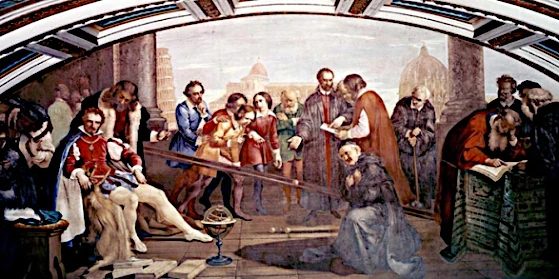
Image: Galileo demonstrating the law of falling bodies to Don Giovanni de Medici.
This equation states that the speed of a free-falling object increases steadily at a rate of 9.81 m/s². In other words, after one second the object will have a speed of 9.81 m/s, after two seconds it will have a speed of 19.62 m/s, and so on. This means that a heavy object and a light object dropped simultaneously from the same height will have exactly the same speed at every instant during their fall.
- v is the speed in meters per second
- g is the acceleration of gravity in meters per square second, which is about 9.81 m/s² on Earth
- t is the time in seconds
A free fall is the movement, in a vacuum, of an object subject only to gravity.
As for the mass of the object, it does not appear in this specific free fall velocity equation.
Mass does not affect the speed of a free falling object in a uniform gravitational field.
If, in a given time, a certain weight traverses a certain space, such other weight will be able to traverse this space in less time; and the times will be in inverse proportion to the weights. For example, if half the weight travels such space in a certain time, twice that weight will travel the same space in half that time."
Aristotle (384-322 BC), Treaty of Heaven (Translation by Jules Barthélemy Saint-Hilaire).
No one will contradict the word of the master and this statement will remain surprisingly false for almost 2000 years. Indeed, Aristotle says that the speed of the fall is proportional to the mass. In other words, if a 27 kg anvil falls at the same time as a 2.7 g ping pong ball, the anvil falls 10,000 times faster, which is not what we observe !!!
Galileo (1564-1642) will have a brilliant idea to verify the law of falling bodies. He will experiment with Aristotle's statement with an inclined plane.
Galileo's law of free fall of bodies was first stated in 1604. This law is considered the first law of modern physics.
The law of falling bodies, or the equivalence principle of free fall, states that in a uniform gravitational field (such as that near the Earth's surface), all objects, regardless of their mass, fall at the same speed, provided that the effects of air resistance are neglected.
In other words, if you drop two different objects from the same height at the same time, they will hit the ground at the same time, regardless of their mass. The difference in their weight plays no role in their falling speed, although their impact force with the ground differs due to their different mass.
Galileo was the first to observe and empirically demonstrate this law. However, it is important to note that modern understanding of this law has developed through the later work of Isaac Newton and the theory of gravity he established. According to Newton's theory of gravity, all objects experience a gravitational force proportional to their mass, the famous formula F=m⋅a. However, this force is also offset by the mass of the object, so the acceleration due to gravity (a) is the same for all objects in a given gravitational field.
In summary, in a vacuum, all objects fall freely with the same acceleration (g), regardless of their mass. Inertia does not affect the acceleration of free-falling objects in a uniform gravitational field. All objects, whether light or heavy, are subject to the same gravitational acceleration approximately equal to 9.81 m/s² on the Earth's surface.